Notre Dame Tourism is absolutely worth it, offering an unforgettable experience steeped in history and architectural brilliance. Let SIXT.VN be your guide to exploring this iconic landmark and the vibrant city of Hanoi. Discover the best travel tips and plan your dream trip to Vietnam, with seamless services designed for international visitors.
1. What Makes Notre Dame Cathedral a Must-See Tourist Destination?
Notre Dame Cathedral is a must-see tourist destination due to its stunning Gothic architecture and rich historical significance. This iconic cathedral, a symbol of Paris, has drawn visitors for centuries with its intricate facade, breathtaking stained glass windows, and captivating history. According to UNESCO, Notre Dame Cathedral exemplifies Gothic architecture and is considered a masterpiece of medieval construction, attracting millions of tourists annually. (UNESCO World Heritage Centre, 1991). It serves not only as a place of worship but also as a cultural and historical touchstone, making it an essential destination for anyone visiting Paris.
Detailed Aspects of Notre Dame’s Appeal:
- Architectural Grandeur: Notre Dame is renowned for its stunning Gothic architectural details, including its flying buttresses, gargoyles, and towering spires. The cathedral showcases the pinnacle of medieval design and engineering.
- Historical Significance: The cathedral has been a central figure in French history since its construction began in 1163. It has witnessed coronations, revolutions, and countless historical events, adding to its allure.
- Artistic Treasures: Notre Dame houses numerous artistic treasures, including intricate sculptures, religious relics, and of course, the famous rose windows. These artistic elements provide deep insights into the cultural and religious beliefs of the time.
- Cultural Icon: More than just a building, Notre Dame is a cultural icon representing Paris and France. Its image is recognized globally, and it embodies the spirit and history of the city.
- Accessibility: Situated on the Île de la Cité, the cathedral is easily accessible, making it a central point for tourists exploring Paris.
- Resilience: Despite the devastating fire in 2019, Notre Dame’s ongoing restoration symbolizes resilience and hope. Visitors are drawn to witness its rebirth and to pay homage to its enduring legacy.
Visiting Notre Dame offers a unique opportunity to connect with centuries of art, history, and culture. Whether you are an architecture enthusiast, a history buff, or simply a traveler seeking profound experiences, Notre Dame Cathedral promises an enriching and memorable visit.
2. Where Exactly is Notre Dame de Paris Located?
Notre Dame de Paris is located on Île de la Cité, an island in the Seine River, which is the historical and geographical heart of Paris, France. This location is not just a picturesque setting but also a significant historical site, making it easily accessible and a focal point for visitors exploring the city. Île de la Cité has been inhabited since ancient times and is considered the birthplace of Paris.
Details on the Location’s Significance:
- Historical Heart: Île de la Cité is where the first settlements of Paris were established, making it the historical heart of the city. The island has been a center of power and religion for over 2000 years.
- Geographical Center: The island’s central location in the Seine River makes it a natural meeting point and a strategic location for the city’s development.
- Accessibility: Île de la Cité is well-connected to the rest of Paris via bridges and public transportation, making it easy for tourists to reach Notre Dame and other attractions on the island.
- Surrounding Attractions: Besides Notre Dame, Île de la Cité is home to other notable landmarks such as Sainte-Chapelle and the Conciergerie, enhancing the visitor experience.
- Symbolic Importance: The location of Notre Dame on Île de la Cité reinforces its symbolic importance as a central point of French history and culture.
How to Get There:
- Metro: The closest metro station is Cité (Line 4), which is directly on Île de la Cité.
- Bus: Several bus lines serve the area, including lines 21, 27, 38, 47, 85, and 96.
- Walking: Notre Dame is easily accessible by foot from many central Paris locations, offering a scenic walk along the Seine River.
- Taxi/Ride-Sharing: Taxis and ride-sharing services like Uber are readily available in Paris and can drop you off near the cathedral.
Understanding the location of Notre Dame de Paris is essential for planning your visit and appreciating its historical and cultural context. Its central position on Île de la Cité makes it a convenient and significant landmark to explore during your trip to Paris.
3. How Has Notre Dame’s History Shaped Its Significance?
Notre Dame’s history has profoundly shaped its significance by embedding it in the cultural, religious, and political narrative of France. Originally built on the site of a Roman temple and later two basilicas, the cathedral’s foundation reflects layers of historical and religious importance. According to historical records, the construction of Notre Dame began in 1163 under the reign of Louis VII, and it took nearly two centuries to complete ( timeline from the official Notre Dame website). This long construction period allowed for the integration of various architectural styles and artistic influences, enhancing its cultural value.
Key Historical Events and Their Impact:
- Medieval Origins: The decision to build Notre Dame in the 12th century marked Paris as a major religious and political center. The cathedral symbolized the power and piety of the French monarchy and the Catholic Church.
- French Revolution: During the French Revolution, Notre Dame was desecrated and repurposed as a Temple of Reason. This period of upheaval and transformation left lasting marks on the cathedral, reminding visitors of France’s tumultuous past.
- 19th-Century Restoration: In the 19th century, architect Eugène Viollet-le-Duc led a significant restoration effort, reviving the cathedral’s Gothic splendor. This restoration not only preserved the cathedral but also added new architectural elements, such as the iconic spire.
- World Wars: Notre Dame survived both World Wars relatively unscathed, standing as a symbol of hope and resilience for the French people.
- 2019 Fire: The devastating fire in 2019 captured global attention and sparked a worldwide effort to restore the cathedral. This event underscored Notre Dame’s importance as a cultural icon and galvanized international support for its preservation.
How Historical Events Enhanced Notre Dame’s Significance:
- Symbol of Resilience: The cathedral’s ability to withstand wars, revolutions, and natural disasters has made it a symbol of resilience and endurance.
- Cultural Identity: Notre Dame represents the cultural identity of France, embodying its artistic, religious, and historical heritage.
- Pilgrimage Site: For centuries, Notre Dame has been a pilgrimage site for Catholics and a spiritual destination for people from all walks of life.
- Architectural Marvel: The cathedral’s blend of architectural styles reflects the evolution of French art and engineering, making it a unique and invaluable historical artifact.
- Tourist Attraction: Today, Notre Dame attracts millions of tourists each year, drawn by its history, architecture, and cultural significance.
Notre Dame’s layered history enriches the visitor experience, offering a profound connection to the past and a deeper understanding of French identity. Whether you are interested in medieval architecture, religious history, or cultural symbolism, Notre Dame offers a captivating and educational journey through time.
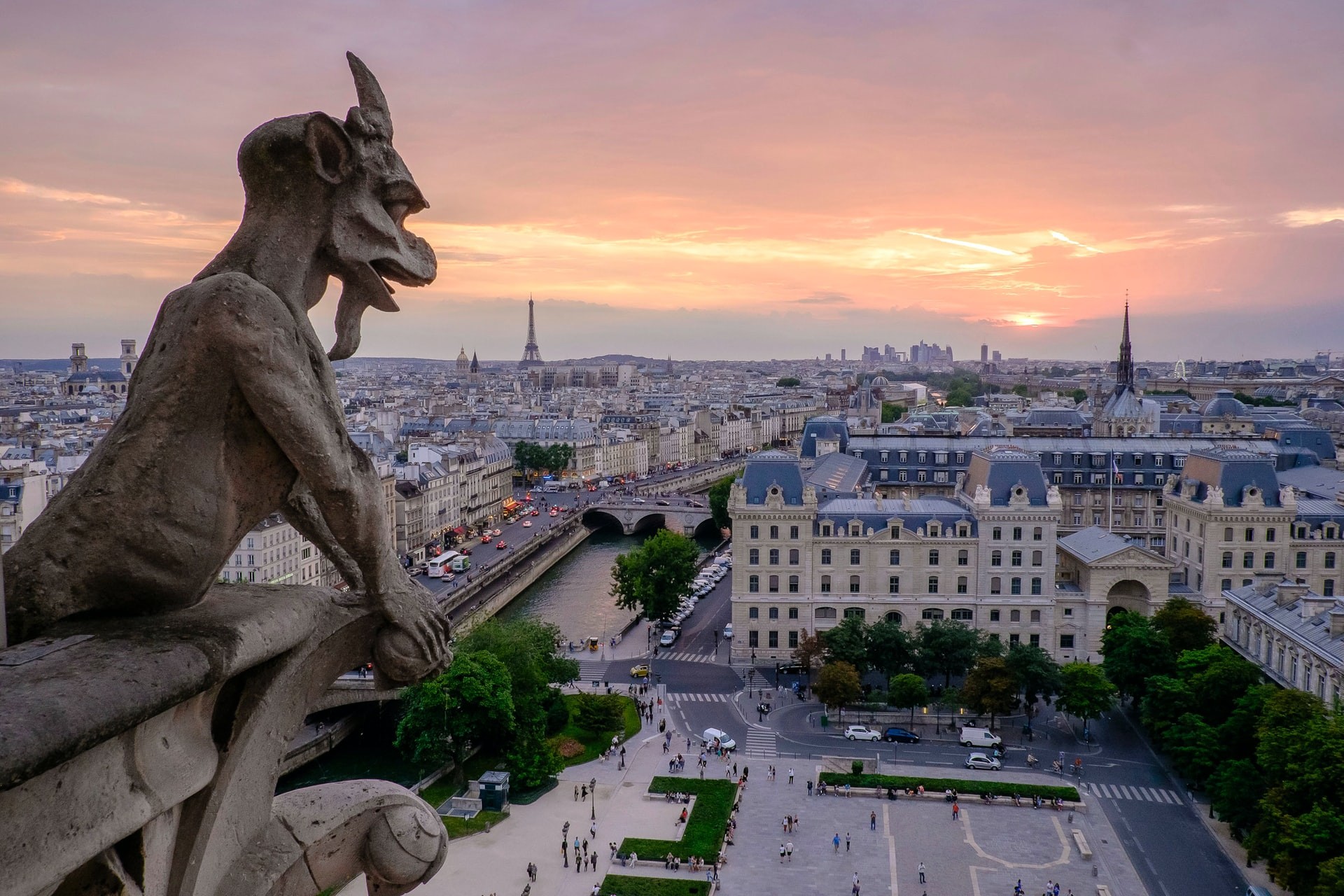 Notre Dame Gargoyle
Notre Dame Gargoyle
4. What Happened During the Notre Dame Fire and What Was Saved?
During the Notre Dame fire on April 15, 2019, a significant portion of the cathedral was damaged, but many important artifacts and structures were successfully saved. The fire, which began in the attic during renovation work, caused the collapse of the spire and much of the roof.
Extent of the Damage:
- Roof: A large portion of the oak roof, known as “the forest” due to its extensive timber framework, was destroyed.
- Spire: The iconic 19th-century spire, designed by Eugène Viollet-le-Duc, collapsed, causing significant damage to the interior.
- Interior: The interior suffered water and smoke damage, and some areas were affected by falling debris.
Items and Structures Saved:
- Main Structure: The two bell towers and the main stone structure of the cathedral were saved, preventing a complete collapse.
- Relics: Important religious relics, including the Crown of Thorns and a tunic believed to have been worn by Saint Louis, were rescued.
- Artworks: Many artworks and religious artifacts were moved to safety before the fire could spread further.
- Rose Windows: Although some stained glass was damaged, the famous rose windows largely survived.
- Organs and Bells: The cathedral’s organs and bells were mostly intact, though they required cleaning and restoration.
Key Salvage Efforts:
- Firefighters: The heroic efforts of firefighters were crucial in containing the blaze and preventing further damage to the cathedral.
- Emergency Response Teams: Teams of experts worked quickly to remove and protect valuable artifacts and artworks.
- Community Support: Parisians and people around the world expressed their support and offered assistance in the restoration efforts.
Immediate Aftermath:
- Assessment: In the days following the fire, experts assessed the structural integrity of the cathedral and began planning for its restoration.
- Donations: An outpouring of donations from individuals, corporations, and governments worldwide provided the financial support needed for the extensive restoration project.
Despite the extensive damage, the successful salvage of key structures and artifacts ensured that Notre Dame’s legacy would endure. The fire served as a catalyst for a global effort to restore this iconic landmark, preserving its cultural and historical significance for future generations.
5. When Did Notre Dame Reopen and What Can Visitors Expect?
Notre Dame Cathedral officially reopened on December 7, 2024, marking a significant milestone after extensive restoration efforts following the 2019 fire. The reopening ceremony included remarks by the French president, chanting of psalms, and organ music, celebrating the cathedral’s rebirth. Visitors can expect a blend of the restored original features and newly renovated elements.
What Visitors Can Expect:
- Restored Architecture: The cathedral’s iconic Gothic architecture has been meticulously restored, including the rebuilt spire and repaired roof.
- Cleaned and Enhanced Interior: The interior has been cleaned and enhanced, revealing the original beauty of the stone and stained glass.
- Relics and Artworks: The cathedral’s religious relics and artworks are back on display, allowing visitors to admire these cultural treasures.
- Rose Windows: The famous rose windows have been carefully restored, casting colorful light into the cathedral’s interior.
- Organs and Bells: The organs and bells have been repaired and are once again part of the cathedral’s services and events.
Practical Information for Visitors:
- Tickets: Entry to the cathedral is free, but visitors must reserve tickets online in advance to manage crowds.
- Security: Expect security checks upon entry, including bag inspections and metal detectors.
- Accessibility: The cathedral is accessible to visitors with disabilities, with ramps and elevators available.
- Masses: Masses are held twice daily and are open to the public.
- Guided Tours: Guided tours are available for those who want to learn more about the history and architecture of the cathedral.
Post-Reopening Events:
- Special Masses: The reopening was followed by eight days of special masses, with the public invited to attend.
- Cultural Events: Expect a variety of cultural events and concerts to be held at the cathedral throughout the year.
Visiting Notre Dame after its reopening offers a unique opportunity to witness the resilience and rebirth of this iconic landmark. Whether you are a first-time visitor or a returning admirer, the restored cathedral promises an enriching and memorable experience.
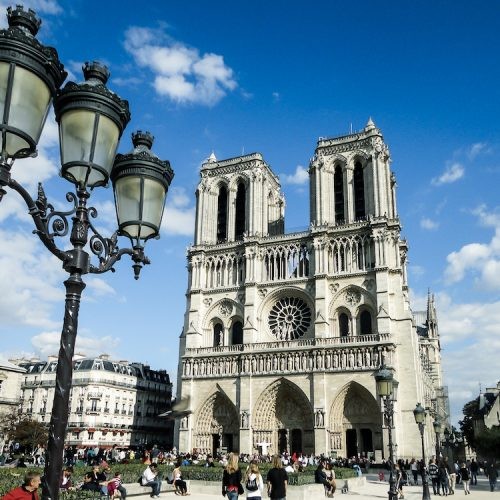 Notre Dame
Notre Dame
6. What Activities and Attractions Are Available Near Notre Dame?
Near Notre Dame, numerous activities and attractions offer a rich cultural experience. Situated on Île de la Cité, the cathedral is surrounded by historical sites, museums, and charming neighborhoods, making it an ideal starting point for exploring Paris.
Top Attractions Near Notre Dame:
- Sainte-Chapelle: A short walk from Notre Dame, Sainte-Chapelle is renowned for its stunning stained glass windows. Built in the 13th century, this royal chapel is a masterpiece of Gothic architecture.
- La Conciergerie: Located on Île de la Cité, La Conciergerie was once a royal palace and later a prison during the French Revolution. It offers a glimpse into the darker side of Parisian history.
- Shakespeare and Company: Just across the Seine, this iconic English-language bookstore is a haven for book lovers. It has a rich history and has been a meeting place for writers and artists for decades.
- Latin Quarter: Explore the vibrant Latin Quarter, known for its historic Sorbonne University, lively cafes, and bookstores.
- Musée d’Orsay: A 20-minute walk along the Seine will bring you to the Musée d’Orsay, housed in a former railway station. The museum features an impressive collection of Impressionist and Post-Impressionist art.
- Luxembourg Gardens: A 15-minute walk from Notre Dame, the Luxembourg Gardens offer a tranquil escape with beautiful fountains, sculptures, and manicured lawns.
Activities to Enjoy:
- Seine River Cruises: Take a scenic cruise along the Seine River to admire Paris’s landmarks from a different perspective.
- Walking Tours: Join a guided walking tour to discover the history and hidden gems of the Île de la Cité and the surrounding neighborhoods.
- Food Tours: Explore the culinary delights of the Latin Quarter with a food tour, sampling traditional French pastries, cheeses, and wines.
- Shopping: Browse the boutiques and souvenir shops along the streets near Notre Dame for unique gifts and mementos.
Recommended Itineraries:
- Historical Day: Visit Notre Dame, Sainte-Chapelle, and La Conciergerie to delve into the history of Paris.
- Art and Culture Day: Explore the Musée d’Orsay and the Latin Quarter, visiting art galleries and bookstores.
- Relaxation Day: Stroll through the Luxembourg Gardens, enjoy a picnic, and soak in the Parisian atmosphere.
Exploring the area around Notre Dame offers a diverse range of experiences, from historical landmarks to cultural hotspots and relaxing green spaces. Whether you are interested in history, art, or simply soaking in the Parisian ambiance, the area around Notre Dame has something to offer every traveler.
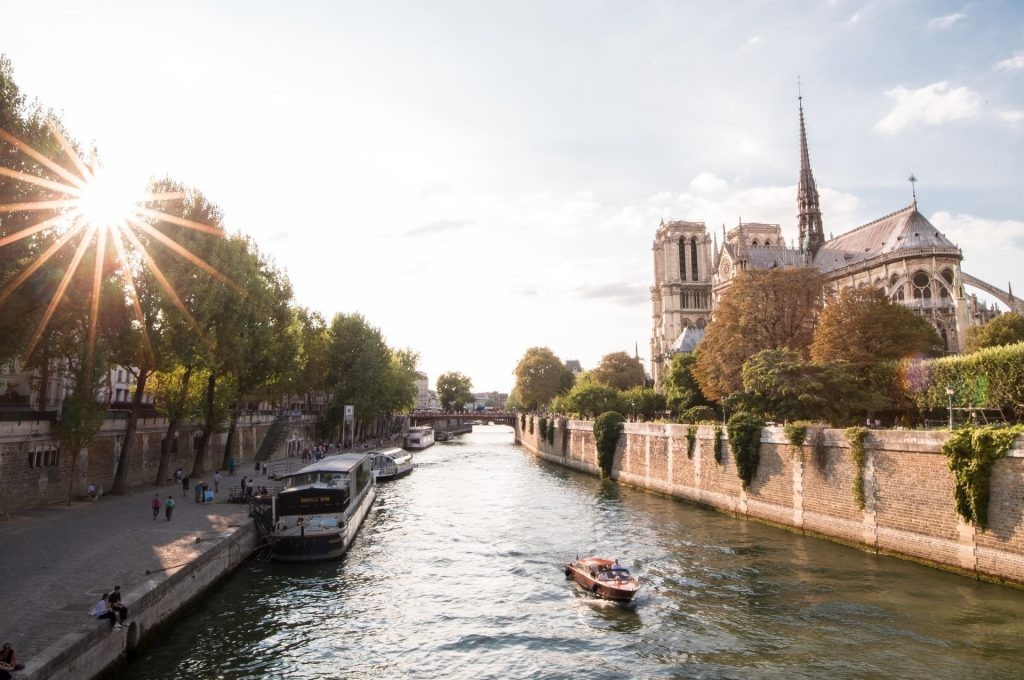 Notre Dame from the Seine River in Paris
Notre Dame from the Seine River in Paris
7. How Can Guided Tours Enhance Your Notre Dame Experience?
Guided tours can significantly enhance your Notre Dame experience by providing in-depth knowledge, historical context, and unique insights that you might miss on your own. A knowledgeable guide can bring the history and architecture of Notre Dame to life, making your visit more engaging and memorable.
Benefits of Guided Tours:
- Expert Knowledge: Guides provide expert knowledge about the history, architecture, and cultural significance of Notre Dame.
- Historical Context: Tours offer a deeper understanding of the events and figures that shaped the cathedral’s story.
- Hidden Gems: Guides can point out hidden details and lesser-known facts that you might not notice on your own.
- Personalized Experience: Many tours offer personalized experiences tailored to your interests and preferences.
- Time Efficiency: Guided tours help you make the most of your time by efficiently covering the most important aspects of the cathedral.
Types of Guided Tours:
- Historical Tours: Focus on the history of Notre Dame, from its medieval origins to its recent restoration.
- Architectural Tours: Highlight the architectural features of the cathedral, explaining the Gothic style and the symbolism behind the design.
- Art and Relics Tours: Showcase the artworks and religious relics housed in Notre Dame, providing insights into their historical and cultural significance.
- Walking Tours: Combine a visit to Notre Dame with a tour of the surrounding Île de la Cité and Latin Quarter.
What to Look for in a Guided Tour:
- Reputable Tour Operators: Choose tour operators with positive reviews and experienced guides.
- Small Group Sizes: Opt for smaller group sizes to ensure a more personalized and intimate experience.
- Knowledgeable Guides: Look for guides with expertise in art history, architecture, or French history.
- Comprehensive Itineraries: Select tours that cover the most important aspects of Notre Dame and its surroundings.
Booking a Guided Tour:
- Online Booking: Many tour operators offer online booking options, allowing you to reserve your spot in advance.
- Hotel Concierge: Your hotel concierge can recommend and book guided tours for you.
- Tourist Information Centers: Visit local tourist information centers for information on guided tours and other activities.
A guided tour can transform your visit to Notre Dame from a simple sightseeing trip into a deeply enriching and educational experience. By providing expert knowledge, historical context, and unique insights, a guided tour can help you appreciate the full significance of this iconic landmark.
8. How Did Local Children Contribute to Notre Dame’s Restoration?
Local children contributed to Notre Dame’s restoration through creative artwork displayed on the fence surrounding the construction site. These drawings imagined what an ideal Notre Dame could contain, offering a heartwarming and hopeful perspective during the rebuilding process. This initiative not only engaged the community but also provided a source of inspiration and joy during a challenging time.
Details of the Children’s Contributions:
- Artwork Display: The fence around Notre Dame was adorned with drawings and paintings created by local children.
- Creative Themes: The artwork depicted various themes, from imaginative architectural additions to messages of hope and resilience.
- Community Engagement: The project involved local schools and community organizations, encouraging children to participate and express their creativity.
- Public Display: The public display of the artwork allowed visitors and locals to appreciate the children’s contributions and feel a sense of connection to the restoration project.
Impact of the Children’s Artwork:
- Inspiration: The children’s artwork provided inspiration for the restoration team and the community, showcasing the importance of hope and imagination.
- Community Spirit: The project fostered a sense of community spirit, bringing people together to support the restoration efforts.
- Emotional Support: The artwork offered emotional support during a difficult time, reminding people of the beauty and resilience of Notre Dame.
- Positive Publicity: The children’s contributions generated positive publicity for the restoration project, highlighting the community’s involvement and dedication.
Examples of Creative Ideas:
- Waterpark Inside Notre Dame: One popular suggestion was to install a waterpark inside the cathedral, showcasing the children’s imaginative and playful ideas.
- Gardens and Green Spaces: Many drawings depicted gardens and green spaces surrounding Notre Dame, reflecting a desire for beauty and tranquility.
- Messages of Hope: The artwork included messages of hope, love, and solidarity, expressing the children’s support for the restoration efforts.
The local children’s contributions to Notre Dame’s restoration were a testament to the power of creativity, community engagement, and hope. Their artwork not only beautified the construction site but also provided inspiration and emotional support during a challenging time, reminding everyone of the enduring spirit of Notre Dame.
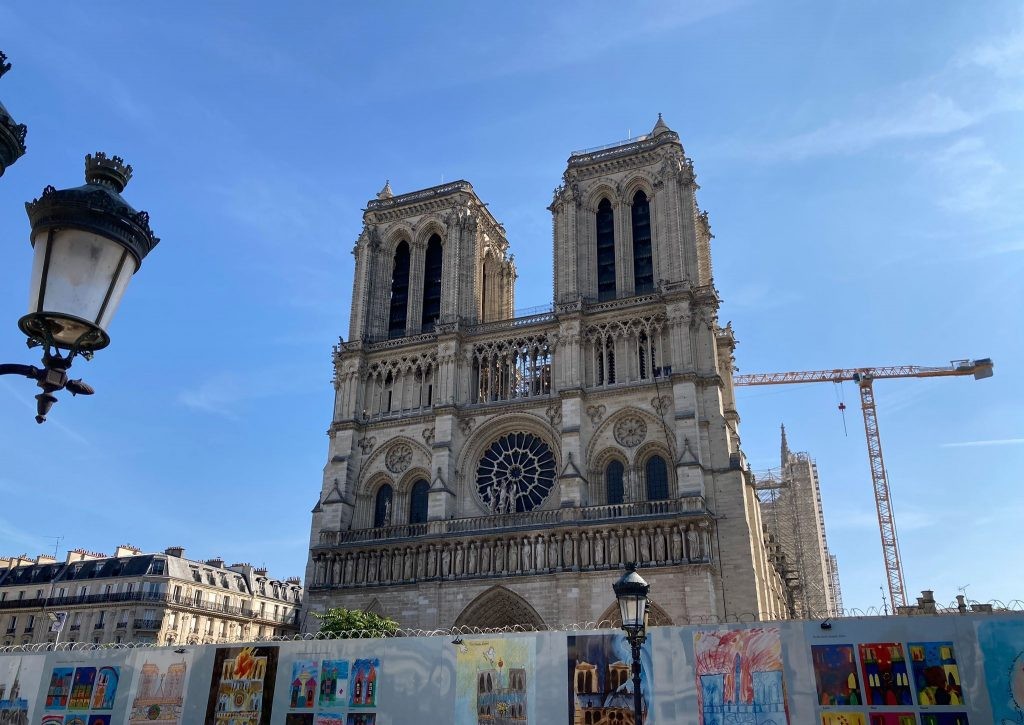 Notre Dame front with wall and drawings and lamp post
Notre Dame front with wall and drawings and lamp post
9. What Travel Advice Should Visitors Know Before Visiting Notre Dame?
Before visiting Notre Dame, travelers should be aware of several key pieces of advice to ensure a smooth and enjoyable experience. Planning ahead, understanding the current situation, and respecting the site are crucial for a fulfilling visit.
Key Travel Advice:
- Book Tickets in Advance: As entry is free but requires a reservation, book your tickets online in advance to avoid long queues and ensure entry.
- Check Opening Hours: Verify the cathedral’s opening hours and any special event schedules on the official website before your visit.
- Arrive Early: Arrive early in the day to avoid the largest crowds, especially during peak tourist season.
- Security Checks: Be prepared for security checks upon entry, including bag inspections and metal detectors.
- Dress Code: Dress respectfully when visiting Notre Dame. Avoid wearing shorts, sleeveless shirts, or revealing clothing.
- Photography: Check the rules regarding photography inside the cathedral. Flash photography may be prohibited.
- Accessibility: Notre Dame is accessible to visitors with disabilities, but it’s advisable to check the availability of ramps and elevators in advance.
- Respectful Behavior: Maintain a respectful demeanor inside the cathedral. Speak quietly and avoid disruptive behavior.
- Learn Basic French Phrases: Knowing a few basic French phrases can enhance your interactions with locals and show respect for the culture.
- Stay Aware of Your Surroundings: Be aware of your surroundings and take precautions against pickpockets, especially in crowded areas.
Practical Tips for a Smooth Visit:
- Transportation: Plan your transportation to and from Notre Dame in advance. The closest metro station is Cité (Line 4).
- Accommodation: Book your accommodation well in advance, especially if you are traveling during peak season.
- Travel Insurance: Consider purchasing travel insurance to protect yourself against unforeseen events, such as illness or travel delays.
- Weather: Check the weather forecast and dress accordingly. Paris can be unpredictable, so it’s a good idea to bring layers.
- Emergency Contacts: Keep a list of emergency contacts, including the local embassy or consulate, and the phone number for emergency services.
By following this travel advice, visitors can ensure a safe, respectful, and enjoyable experience at Notre Dame, making the most of their time at this iconic landmark.
10. What Alternative Paris Landmarks Should You Explore?
While Notre Dame is a must-see landmark, Paris offers numerous alternative attractions that are equally captivating and worth exploring. From historic churches to world-class museums and charming neighborhoods, there is something for every traveler to enjoy.
Alternative Paris Landmarks:
- Sainte-Chapelle: Known for its breathtaking stained glass windows, Sainte-Chapelle is a masterpiece of Gothic architecture and a must-visit for art and history enthusiasts.
- Sacré-Cœur Basilica: Located on the highest point of Montmartre, the Sacré-Cœur Basilica offers stunning panoramic views of Paris and is renowned for its beautiful architecture.
- The Louvre Museum: Home to iconic artworks such as the Mona Lisa and Venus de Milo, the Louvre is one of the world’s largest and most famous museums.
- Eiffel Tower: A symbol of Paris, the Eiffel Tower offers breathtaking views of the city and is a must-visit for first-time visitors.
- Arc de Triomphe: Standing at the center of Place Charles de Gaulle, the Arc de Triomphe is a monument honoring those who fought in the Napoleonic Wars.
- Panthéon: A neoclassical monument in the Latin Quarter, the Panthéon houses the tombs of notable French figures such as Voltaire, Rousseau, and Victor Hugo.
- Musée d’Orsay: Housed in a former railway station, the Musée d’Orsay features an impressive collection of Impressionist and Post-Impressionist art.
- Luxembourg Gardens: A beautiful park in the Latin Quarter, the Luxembourg Gardens offer a tranquil escape with fountains, sculptures, and manicured lawns.
- Montmartre: A charming hilltop neighborhood known for its artistic history, Montmartre offers stunning views of Paris and is home to the Sacré-Cœur Basilica and the Place du Tertre.
- Le Marais: A historic district with narrow streets, trendy boutiques, and vibrant nightlife, Le Marais is known for its Jewish heritage and LGBTQ-friendly atmosphere.
Why Explore Alternative Landmarks:
- Diverse Experiences: Paris offers a diverse range of experiences, from historical sites to world-class museums and charming neighborhoods.
- Avoid Crowds: Exploring alternative landmarks can help you avoid the crowds at popular attractions such as Notre Dame and the Eiffel Tower.
- Discover Hidden Gems: Many of Paris’s alternative landmarks are hidden gems that offer unique and authentic experiences.
- Learn More About French History and Culture: Each landmark tells a story about French history and culture, providing a deeper understanding of the city.
Exploring alternative Paris landmarks can enhance your travel experience and provide a more comprehensive understanding of the city’s rich history, culture, and beauty. Whether you are interested in art, history, or simply soaking in the Parisian atmosphere, there is something for everyone to discover.
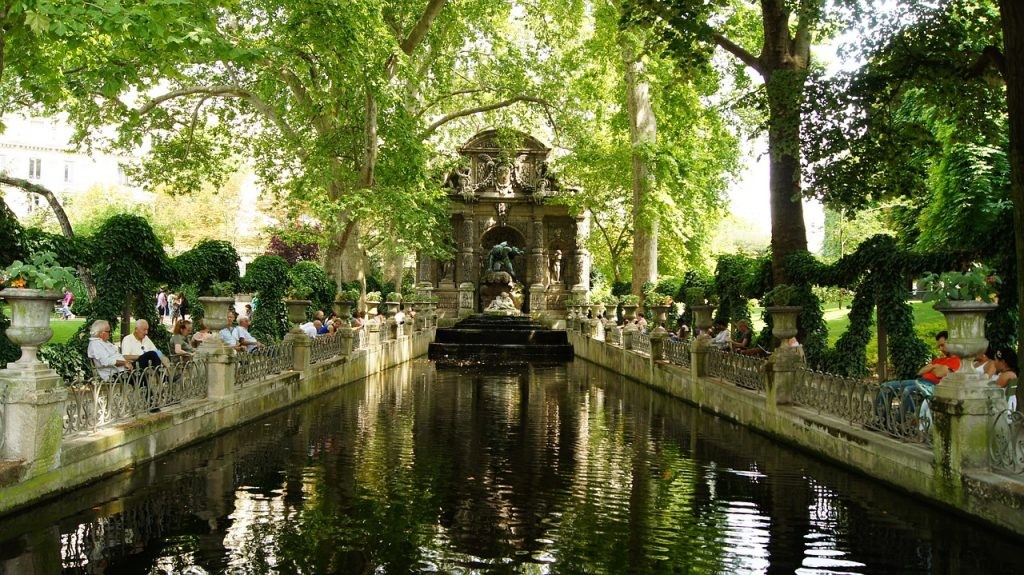 Medici Fountain in Luxembourg Gardens for Paris city tour
Medici Fountain in Luxembourg Gardens for Paris city tour
Navigating Hanoi with SIXT.VN: Your Premier Travel Partner
While your heart may be set on the Gothic splendor of Notre Dame, SIXT.VN invites you to discover the enchanting beauty of Hanoi, Vietnam. We understand the challenges international travelers face, which is why we offer a comprehensive suite of services designed to make your trip seamless and unforgettable.
Comprehensive Services Tailored for International Travelers
SIXT.VN provides a range of services specifically designed to cater to the needs of international tourists:
- Visa Assistance: Navigating visa requirements can be daunting. We offer guidance and support to ensure you have the necessary documents for entry into Vietnam.
- Airport Transfers: Start your trip stress-free with our reliable and comfortable airport transfer services. Our drivers will greet you upon arrival and transport you to your hotel safely and efficiently.
- Hotel Booking: We partner with a wide range of hotels to offer you the best options for your budget and preferences. Whether you’re looking for luxury accommodations or a budget-friendly stay, we’ve got you covered.
- Tour Packages: Explore Hanoi and its surrounding areas with our curated tour packages. From cultural excursions to adventure tours, we offer a variety of itineraries to suit your interests.
- Translation Services: Overcome language barriers with our professional translation services, ensuring smooth communication throughout your trip.
- SIM Card and Local Transportation: Stay connected with our SIM card services and enjoy convenient local transportation options to explore Hanoi at your own pace.
Seamless and Reliable Travel Solutions
At SIXT.VN, we prioritize your comfort and convenience. Our services are designed to be seamless and reliable, ensuring you have a stress-free travel experience.
- Online Booking: Easily book all your travel services online through our user-friendly platform.
- 24/7 Customer Support: Our dedicated customer support team is available 24/7 to assist you with any queries or concerns.
- Flexible Options: We offer flexible booking options, allowing you to customize your itinerary according to your preferences.
- Transparent Pricing: Enjoy transparent pricing with no hidden fees, ensuring you get the best value for your money.
- Secure Payment: Our secure payment gateway ensures your financial information is protected.
Why Choose SIXT.VN for Your Hanoi Adventure?
- Expertise: With years of experience in the travel industry, we have the expertise to provide you with the best travel solutions.
- Reliability: We are committed to providing reliable and trustworthy services, ensuring you have a smooth and hassle-free trip.
- Convenience: Our comprehensive range of services makes it easy for you to plan and book your entire trip in one place.
- Customer Satisfaction: We prioritize customer satisfaction and go the extra mile to ensure you have a memorable travel experience.
Start Planning Your Unforgettable Hanoi Adventure with SIXT.VN
Ready to explore the beauty and charm of Hanoi? Let SIXT.VN be your trusted travel partner. Visit our website or contact us today to start planning your unforgettable adventure. With our seamless services and expert support, you can focus on creating memories that will last a lifetime.
Address: 260 Cau Giay, Hanoi, Vietnam
Hotline/WhatsApp: +84 986 244 358
Website: SIXT.VN
Embark on a journey of discovery with SIXT.VN and experience the best of Hanoi and beyond. Your adventure awaits!
Frequently Asked Questions (FAQ) about Notre Dame Tourism
1. Is Notre Dame Cathedral open to the public?
Yes, Notre Dame Cathedral reopened to the public on December 7, 2024, after extensive restoration work following the 2019 fire.
2. Do I need to book tickets in advance to visit Notre Dame?
Yes, entry to Notre Dame is free, but visitors must reserve tickets online in advance to manage crowds.
3. What are the opening hours of Notre Dame?
It’s advisable to check the official Notre Dame website for the most current opening hours and any special event schedules.
4. What should I wear when visiting Notre Dame?
Dress respectfully when visiting Notre Dame. Avoid wearing shorts, sleeveless shirts, or revealing clothing.
5. Are there security checks at Notre Dame?
Yes, be prepared for security checks upon entry, including bag inspections and metal detectors.
6. Can I take photos inside Notre Dame?
Check the rules regarding photography inside the cathedral. Flash photography may be prohibited.
7. Is Notre Dame accessible to visitors with disabilities?
Yes, Notre Dame is accessible to visitors with disabilities, but it’s advisable to check the availability of ramps and elevators in advance.
8. What happened to Notre Dame during the 2019 fire?
The fire caused significant damage to the roof and spire of Notre Dame, but many important artifacts and structures were saved.
9. What are some alternative attractions to visit near Notre Dame?
Some alternative attractions near Notre Dame include Sainte-Chapelle, La Conciergerie, Shakespeare and Company, and the Latin Quarter.
10. How can a guided tour enhance my visit to Notre Dame?
A guided tour can provide expert knowledge, historical context, and unique insights that you might miss on your own, making your visit more engaging and memorable.



